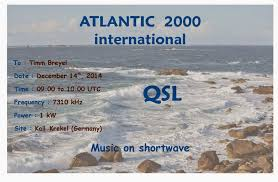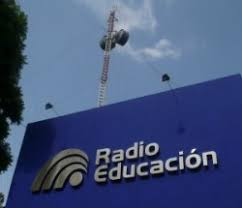Welcome to the May 2024 edition of Blog Logs. Thank you for your emails and for following the Shortwave Central blog and X/Twitter at Shortwave Central @QSLRptMT.
Thank you to all the contributors for sharing their loggings – do you have any loggings or information to share for the next edition of Blog Logs? Your input from mediumwave, or shortwave is welcome at:
w4gvhla@gmail.com Tell the world what you're hearing from your listening post or portable monitoring!
Have you subscribed to the Shortwave Central YouTube channel? There is a large selection of videos and audio airchecks, with more planned for the future! Join your fellow radio enthusiasts at:
https://www.youtube.com/c/ShortwaveCentral
By following the Shortwave Central blog and on X/Twitter, you will find tips and information from the ever-changing realm of radio!
Blog Logs Issue # 5
Language services, SDR or receivers as indicated.
// denotes station heard on a parallel frequency
*Sign-on Sign-Off*
All frequencies in kilohertz
Monitored 14 April - 14 May 2024
All times UTC
Mediumwave
570, Rádio Eldorado, Criciuma SC, 2225. Sports news ‘Avail FC)’ ads for “Supermercado (?) Criciuma Tubarão. SINPO 34433. Best reception on USB and interference from 560 Rádio Deus é Amor, Santa Isabel.
590, Rádio 79, Ribeirão Preto SP, 2115 with sports talk, news to “Betafogo de Ribeirão Preto.” SINPO 35553.
730, Rádio Cidade, Jundiai, SP 2158. Sports news, station ID “ZYK523 Rádio Cidade…a voz do Brasil” on 2200. Interference from Rádio Trianon, São Paulo SP.
750, Rádio América, Belo Horizonte MG, 2234. Brazilian songs, oldies, and station promo. SINPO 22432. Interference from Rádio CBN Vale, São José dos Campos SP. Also on 580 with religious broadcasting. SINPO 24422.
750, Rádio CBN Vale, São José dos Campos SP. At 2231 with ID as “CBN,” into news bulletin. SINPO 33433. Interference from Rádio América, Belo Horizonte MG.
820, Rádio Jauense, Jaú SP at 2206. Sports program, “Quinze de Jaú…jogo na cidade de Barretos.” SINPO 24522.
1160, Rádio Cacique, Taubaté SP, 2156. “noticias das Estrada do Vale do Paraiba, Conexão da Tarde”, grupo de emissoras Coligadas…” SINPO 34333.
1320 Rádio Tropical Gospel, Curitiba PR at 2204. “Igreja Visão Missionária..” Commercials for Curitiba, Cajuru, Missionário Alexandre da Rosa.” SINPO 35553.
1380, Rádio Cidade, Brasópolis MG at 2156. Brazilian song, station jingle, and ID “ZYL218 AM 1380 Rádio Cidade, Brasópolis, Minas Gerais.” SINPO 35443. (Rudolf Grimm, São Bernardo SP, Brazil).
Kuwait
630, Radio Kuwait, Quran Channel (Madirat al-Kuwayt/Al-Masqua 2210-2220. Ongoing Arabic Quran recitations in progress at tune-in. This is a 24-hour station.
1134, Radio Kuwait Multilingual Channel 2215-2225. Arabic programs including clear ID, and program previews into the presentation.
1548, USAGM/Radio Farda 1548-1555. Clear ID at tune-in to Arabic easy-listening vocals.
http://www.radiofarda.com Station at Al-Kuwayt/Umm al-Rimam 1630-2330 schedule. (Van Horn/Kiwi Qatar SDR)
Paraguay
650, Radio Uno, Asunción. Spanish at 2324. Sports commentary for ‘futebol.’ (soccer). Guarani, Sudamericana. Station comments with SINPO 24332. (Rudolf Grimm, São Bernardo SP, Brazil).
Peru
1360, Radio Sicuani, 2330-0020. Spanish. Music which was presumed to be in Quechua and mentions of “provincial de Canchis.” Noted Sicuani is the capital of Canchis province. (RealDX/Paul Crankshaw).
United Arab Emirates
846, Umm al-Quwain/Quran Radio 1820-1835 with ongoing Quran recitations.
1476, Radio Keralam, Ras-al-Khaimah with Indi pops, station ID, and jingles. Sitar vocals. (Van Horn/Qatar Kiwi)
Uruguay
1180, Radio La Voz de Artigas, Artigas. Spanish “Sonido professional, como lo sabes tu … Artigas.” Pop music tune, SINPO 25432 ((Rudolf Grimm, São Bernardo SP, Brazil).
Shortwave
Algeria
13790, Radio Ifrikiya FM, 2142. Arabic service including pop music and announcer’s talk. SINPO 35543 with transmission to west Africa (Rudolf Grimm, Sao Bernardo, Brazil
15110, Radio Ifrikiya FM, 0105-0115. Arabic/French programming including regional Arabic and pop vocals. Fair signal SINPO 35433.
15160, Radio Ifrikiya FM, 1725-1727. Arabic vocals from tune-in. Announcer duo’s station promo. Recheck 2155 on 13790 with Afro pops and no // 13590. Afro pops to 2100 time-tips to ID and Arabic script. (G. Van Horn/Kiwi Qatar SDR). https://ifrikyafm.com/
Austria
15440, Adventist World Radio/AWR relay at 2040. French service for religious text and prayer. Announcer’s station info during poor signal quality. (Harold Sellers, Vernon, BC, Canada).
http://www.awr.org
Bolivia
3310, Radio Mosoj Chaski, Cotapachi, 0017-0025. Poor signal with unreadable Spanish comments, Strong carrier for extremely weak audio (Manuel Méndez, Spain/BDXC).
Botswana
6195, USAGM/Voice of America relay Selebi-Phikewe 2055 with lady’s programming including pop music. SINPO 25322 as a target to central Africa. (Grimm).
15580, USAGM/Voice of America relay Selebi-Phikewe 1735-1852. English service of national news and interviews on humanitarian aid to Gaza. Fan-fare melody into replay interview on the annual Easter Egg Roll at the White House. Shift to 6080 no // 4930. Issues In the News segment on Ukraine’s continuing war. Recheck 2010 on 6195. ID to African rap vocals // 4930 (SIO 444) // 909 (SIO 323) (Van Horn/Kiwi Kenya SDR/Kiwi South Africa SDR). http://www.voanews.com
Brazil
6150, Rádio Saturno, Belo Horizonte at 1100 with station ID. Station Portuguese schedule (ex 6170):0430-1455; 2040-2100. Log 0600-0645. (Van Horn).
6180, Rádio Nacional da Amazonia, Brasilia DF at 2050. Station‘s Portuguese identification and announcer’s chat. Instrumental music program. SINPO 45544. Targeted to northern Brazil (Grimm).
http://www.ebc.com.br9665, Voz Missionaria, Cambori?, 0522-0546 // 5940, 11749.9 with Portuguese religious songs. Méndez)
9819 Rádio 9 de Julho, São Paulo 2034-2047 with Portuguese religious songs. SINPO 15421 (Méndez).
11815, Rádio Brasil Central, Goiania, 2033-2048 with Brazilian music. SINPO 35433 (Mendéz)
15190, Rádio Inconfidência at 0102. Portuguese ads to announcers’ frequency quote. Local time check into Brazilian dance music. Fair signal quality as the band is only fair. (Sellers) 1941-2018 with Braz music and ID as “Rádio Inconfidencia, inconfidencia.com.br” SINPO 25432 (Méndez)
http://www.inconfidencia.com.br
Clandestine
6045, Voice of Freedom (tentative) from 0940-0950. Open carrier observed but no audio with North Korean jamming underneath. (Frank Hillton, SC).
9490, Radio República. 0132 Good signal for Spanish broadcast including several ID’s as “Radio República, la voz de la Resistencia Cubana.” (Sellers). The station is prone to jamming by Cuba.
Denmark
5930 World Music Radio, Bramming 2025-2045 with Southern American instrumentals to station identification. (Sam Wright, MS)
Ethiopia
6030, Radio Oromiya, Addis Ababa 1914-1936. East African songs and vernacular comments (Méndez).
6090, Radio Amhara/Amhara State Radio 1745-1805. Male/female with presumed Amharic conversation. Newscast and “Amhara” ID at 1800. SIO 322. (Méndez).
6110, Radio Fana/Fana Broadcasting Corp. 1755-1810. Tune in with program text in presumed Amharic. Poor signal SIO 222. (Van Horn/Kiwi Qatar SDR) The Kiwi Kenya SDR has an ongoing “buzz.”
Euro Free Radio
6275, Radio Argus 1902-1925. English pop tune at tune-in. “Radio Argus” ID at 1902 into new tune. Music titles to DJ Bert Bridges intro for Pink Floyd music. (Van Horn) Additionally found out this was the station’s first broadcast in 21 years, and unfortunately the email address posted on the BDXC email group bounced twice for me! Does anyone have a current address?
5879.97 Radio Rock Revolution 2000-2015 with rock music and DJ’s identification, better in LSB (Giovanni Serra, Roma, Italy/NASWA)
6285.02 Zender Akenzo 2006-2018 with Dutch programming for disco pops (Serra).
Kuwait
15750, USAGM/Radio Mashaal. Pashto program at 1110. SINPO 15321 for transmission to Afghanistan and Pakistan (Grimm).
Liberia
6050, ELWA Radio 0600-0615. The station’s interval signal to ID and greetings to listeners. Religious devotionals and gospel vocals (Van Horn) ** See comments in my Bits & Bytes column on ELWA, in the upcoming June 2024 issue of The
Spectrum Monitor e-zine.
Madagascar
11965 African Pathways Radio at 2033. English service with station’s website information into the program about Eswatini, formerly known an Swaziland. (Sellers).
11610, World Christian Broadcasting 2146. The Light of Life in Chinese. Station identification with station info. SINPO 25532 to Western Europe (Grimm).
México
6185, Radio Educacion, Ciudad de México 0625-0645 and 0100-0135 with classic Mexican music and station IDs. Also noted as Señal Cultura México, schedule 2200-1100 UTC. (Hillton). h
ttp://www.radioeducacion.edu.mx
Norway
5895, Radio Northern Star, Bergen, 2026-2037. English comments and station ID at 2030 “Radio Northern Star.” English pop music for SINPO 25432 (Méndez).
Peru
4820, Radio Senda Cristiana, Cotahuasi, Arequipa, 0018-0127. Spanish programming to religious text. SINPO 15421 (Méndez).
Romania
11620 Radio Romania International at 0011. English service with lady’s newscast for a good signal. 13650 at 2031 with newscast, also on // 11975. Noted on fair quality 11800 at 2219 with a program on health issues (Sellers).
http://www.rri.ro
Thailand
13750, Radio Thailand at 0001. English service covering newscasts by male/female duo. Fair signal. (Sellers).
15090 USAGM/Radio Azadi via Udon Thani. Heard at 0231. Pashto programming to Afghanistan. (Grimm) the station also broadcast this time on 9480.
http://www.azadiradio.com
United Kingdom
3955, SM Radio Dessau 1902-1925. Woofferton, UK relay and replay of earlier broadcast from Germany relay at 1200 and 0800. Classical music to German announcements and the May Day program. (Van Horn/NLD Twente SDR) E-QSL received in three days.
United States
9265, WINB 2045-2050. The signal barely audible through archived audio from Bro. Stair’s sermons // 9665.
9980, WWCR 1850-1905. Parallels 15825 or 13845 not heard. Religious text to hymns, canned station ID into Overcomer Ministry programming; 12160 at 1800-1830; 12160 at 2000-2010; 9350 at 2050-2100 with discussion on current politics and upcoming elections.
9275, WMLK Radio, Bethel, PA 1910-1920. Fair signal from tune-in for archived Elder Jacob O. Meyer religious text. SIO 232. Audible 2045-2055 with very weak text.
5950, WRMI/Radio Tumbril 0200-0220. “Radio Tumbril” identification for Encore classical music program from host Brice Avey. Music from Hummel and Mendelssohn, SINPO 44344
15770, WRMI 2220-2230. Spanish program to Latin America. Station ID; 9455 at 2230 with Overcomer Ministry program; 7730 at 2240 Supreme Master’s program; 5850 Radio Prague French newscasts.
9475, WTWW 2100-2110. Scriptures for America into archived programming from the late Pastor Peter J. Peters from LePorte Church. (Van Horn/SW Central Kiwi SDR LA).
Vanuatu
7260, Radio Vanuatu 0620-0640. Noted a public service format in Bislama, followed by national news and pop vocals. (Hillton).7260, 0610-0655 Poor signal quality but Vanuatu (Wright) https://www.vbtc.vu
Vatican State
9705, Vatican Radio via Santa Maria di Galeria. French service heard at 2029. Interval signal to ID as “Radio Vaticana.” Instrumental music and lady’s program info. SINPO 35543 with programming targeted to Africa. Heard on 21470 via BBC relay in English with sports programming and station station ID. SINPO 35553 to Africa (Grimm).
http://www.vaticannews.va



.png)















.JPG)


